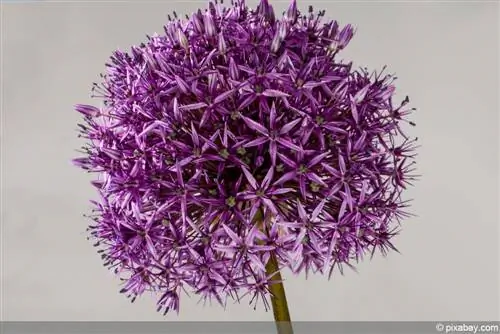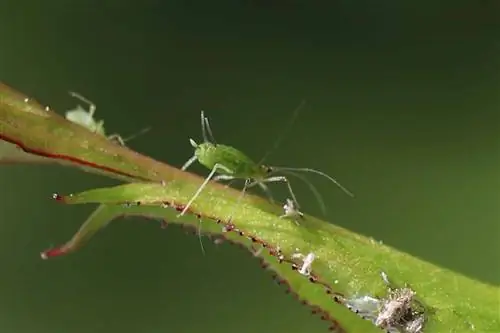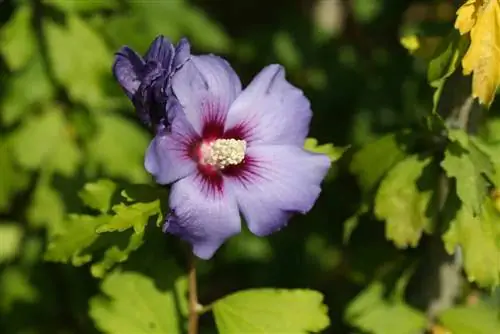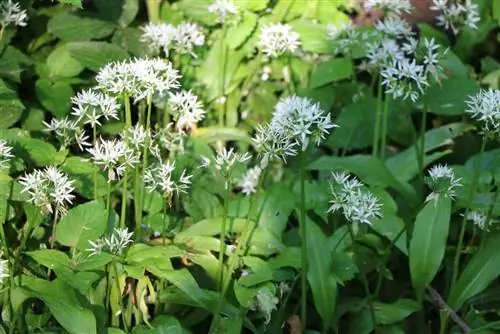- Author admin [email protected].
- Public 2023-12-17 03:39.
- Last modified 2025-06-01 06:48.
Planting garlic professionally is no problem, even for beginner gardeners. As the flowering period begins, the popular spice plant still raises important questions about how to proceed with profitable cultivation. Home gardeners are now primarily racking their brains as to whether the flowers should be cleaned out so that the bulbs in the ground do not lose their aroma or even become inedible. This green guide addresses all questions about the flowering and harvest times. Read here when and how to harvest the spicy cloves. This is how you handle the garlic blossom professionally.
Cut off flowers or not? - Options at a glance
Garlic planted in autumn produces 80 to 100 cm long, tubular stems in June, with isolated flowers at the end. Garlic flowers have little in common with the flowers of flowers and ornamental perennials. In fact, these are pseudo umbels that are usually sterile and therefore do not produce seeds. Instead of fruits with seeds, most garlic varieties produce tiny bulbs, called bulbils, within their inflorescences. Undoubtedly, the plant invests much of its energy in growing these unusual inflorescences. The extent to which the quality of the garlic cloves suffers as a result is controversially discussed among experts and garlic fans. This results in various options for how you can handle the garlic flower:
- Consistently cut off all flowers including the tube stems in order to direct growth energy into the bulb
- Clean out half of the flowers to be able to compare quality
- Just leave a few inflorescences to use the bulbs for propagation
The gourmet garlic gardeners are convinced that non-flowering garlic cloves have a more delicate aroma. Commercial garlic gardeners suspect that the flowers reduce crop yields. In China, however, garlic flowers are bleached, prepared and consumed.
Blooming garlic is edible
Regardless of the alternatives when dealing with the flowers of a garlic plant, one fact is undeniable: There is no direct connection between garlic flowers and edibility. The tasty clove bulbs are edible whether you allow them to bloom or not. The best way to investigate the extent to which the removal of buds and flowers affects quality is to conduct your own experiments using the options mentioned above.
Tip:
While garlic is edible even after flowering, this is not the case for its germinating bulbs. If a green germ emerges from a garlic bulb, please throw it away. The very bitter taste is the lesser evil in this case. Green sprouting garlic bulbs are poisonous and cause considerable discomfort after consumption.
Best harvest date is obvious
Once doubts about the flowering period have been cleared up, the question of the perfect harvest date is undisputed. Winter garlic planted in autumn will be ripe from July under normal weather conditions. Summer garlic planted in spring usually reaches harvest maturity in August. The plant signals the specific date for the harvest with the following attributes:
- The foliage in the upper third of the plant has withered
- The leaves in the lower part turn yellow
- First toes or bulbs can be seen
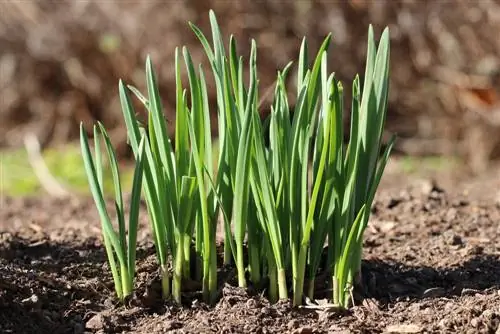
Looking at the calendar provides a rough guide for the start of the harvest season. Only when a plant visually shows that it is ripe should it be harvested. In this context, it is of secondary importance whether it is an annual or two-year-old variety of garlic and whether it was planted in the ground in autumn or spring.
Tip:
Spring is a second choice planting date for garlic. In order to harvest the spice and medicinal plant in premium quality, garden practice has proven to be successful in planting it in September/October.
Harvest garlic skillfully
If a garlic plant meets all the criteria for being ready for harvest, the work is very easy. Hold the above-ground parts of the plant with your hand and pull the bulbs out of the ground. If the soil has hardened due to previous rainfall, first loosen the bed with a digging fork.
After-ripening improves quality
Freshly harvested garlic should continue to ripen for a few days to develop its full aroma. To do this, place the onions in an airy, dry and dark place for about a week. Only then do you cut off the withered leaves.
Conclusion
When garlic plants produce their flowers, the gardener has various options for further action. You can optionally cut off all flower stalks so that the plant invests its energy in growing the coveted bulbs. Unfortunately, the opportunity to benefit from the tiny bulbs within the umbel and to grow new garlic plants from them is lost. The effects of flowers on quality can be found out through your own experiments. It is an irrefutable fact that garlic is edible even after it has bloomed. Only when an onion begins to germinate does it produce toxins and become inedible. The ideal harvest date is associated with fewer uncertainties. As soon as the leaves wither and the first bulbs are visible, garlic can be harvested. To do this, loosen the soil and pull the plant out of the ground. After a week of ripening, cut off the leaves and the time for carefree garlic enjoyment begins.
Source:
www.t-online.de/leben/essen-und-trinken/id_70768120/knoblauch-essen-das-sollten-sie-wissen.html

